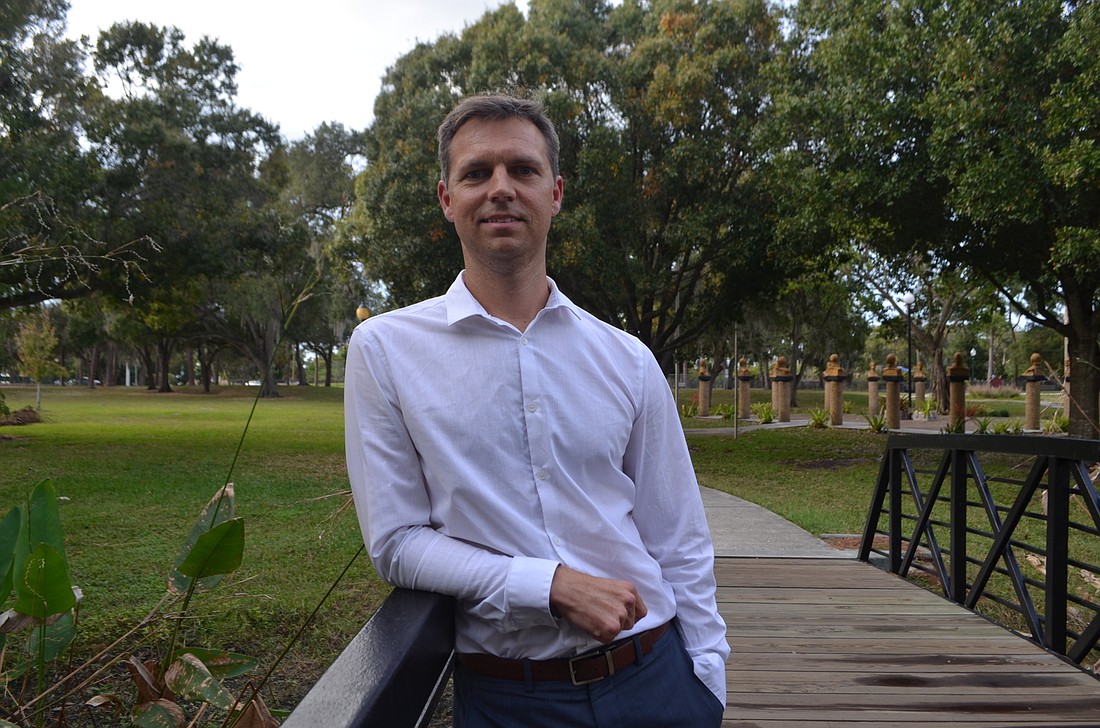- April 29, 2024
-
-
Loading

Loading

After Derin Parks and his family decided to move to Gillespie Park about five years ago, he was struck by the level of organization and activity among his neighbors.
Parks, an attorney, was impressed to see neighborhood association members work hard to make the downtown-adjacent residential area a better place. The group tackled projects that included adding amenities to the neighborhood park and making safety improvements designed to discourage criminal activity.
On occasions when residents were frustrated about an inability to work quickly with the city to address certain neighborhood priorities, Parks was a little confused. Before he moved into the area, he did some research and found the city had established a Gillespie Park Neighborhood Improvement District in 1988.
A city ordinance empowered the district to seek state grants and even establish an additional property tax within the district’s boundaries. It also said there was supposed to be an advisory board, composed of property owners within the district, that worked with the city to develop and implement a neighborhood improvement plan.
So, Parks asked: Why was the association unable to get the city to move quickly to address it? Wasn’t this the city-authorized advisory board for the neighborhood improvement district?
“The response was kind of, ‘Gee, we don’t really know,’” Parks said. “‘We don’t know what that is.’”
The answer was no, he learned. The neighborhood association was independent, not under any city purview. He also learned residents weren’t the only ones who hadn’t heard of the neighborhood improvement district. When he first contacted city officials to get information, they told him it didn’t exist.
Eventually, Parks located the relevant documents to get the city’s attention. In October, the topic made its way in front of the City Commission. Although the Gillespie Park Neighborhood Improvement District had been forgotten, Parks saw it as an opportunity to more quickly address issues residents had. He and other residents lobbied the city to consider reviving the district and using it as a mechanism to empower the neighborhood.
“I think this is a neighborhood that can clearly demonstrate it’s more than up to the task of making life easier for the city and improving the neighborhood,” Parks said.
The commission unanimously directed staff to produce a report about the viability of using the improvement district.
Officials did have some questions and concerns about the district. Some related to the context surrounding the establishment of the district more than 30 years earlier. The district was created specifically under the terms of a state statute authorizing “safe neighborhood improvement districts,” an initiative designed to address criminal activity.
Commissioner Willie Shaw said the city created the district, along with two others, to deal with the conditions of Gillespie Park at the time.
“It was crack-infected,” Shaw said. “That’s the reason you had this ordinance to even come about.”
There were other obstacles. The boundaries of the district weren’t just limited to Gillespie Park, extending east into Park East and west into the Rosemary District. The state statutes required the city to create a “safe neighborhood plan” and document and analyze crime in the area, city attorney Robert Fournier said.
Although the eight Gillespie Park residents who spoke at the meeting were all in favor of reviving the improvement district, Commissioner Hagen Brody said he heard from some people who opposed the concept. If there were issues with neighborhood safety or infrastructure, Brody thought the city should step up to address them rather than leaving it to neighbors.
Parks said he understood that officials worked to address neighborhood concerns, but he said there were certain projects some residents saw as a higher priority than city staff did. He cited issues with sewers in the area. The city said it intends to address those issues in its 10-year utilities master plan, but Parks said the neighborhood thinks swifter action is needed.
Parks acknowledged that the city has budget limitations and a broad focus, but he thought the district could be a platform for addressing the neighborhood’s highest-priority issues.
Brody also expressed concern about the district’s taxing authority and stated that was a major step that could significantly affect residents in the area.
Not everyone in the neighborhood is convinced about the merits of the improvement district. Neighborhood association President Linda Holland appreciates the work Parks is doing, but she wants this conversation to proceed with caution. She said she was uncertain about the level of support for the concept and that although the neighborhood association is active, many Gillespie Park residents aren’t involved.
“Can I tell you it represents everybody in our neighborhood?” Holland said. “Absolutely not.”
Holland had other concerns. She sees the improvement district as a complicated mechanism, hard to easily explain to residents. Getting a resident advisory board to comply with the state Sunshine Law would be challenging, she said. The prospect of an additional property tax would worry some residents. And although she said the concept was interesting, she wasn’t certain it would actually result in the neighborhood getting projects done more quickly.
“You just have to say: ‘Wait a minute. We really need to consider this really seriously,’” Holland said.
The city commission is scheduled to discuss the Gillespie Park Neighborhood Improvement District at a meeting early next year.
Parks remains enthusiastic and eager for the city to take action. He sees the district as an opportunity to help democratize the decision-making process in the neighborhood and create a hyperlocal way to more swiftly respond to challenges as they arise.
“I do know that everyone has issues throughout this particular district, and we would love to be able to hear everybody’s and come up with solutions,” Parks said.